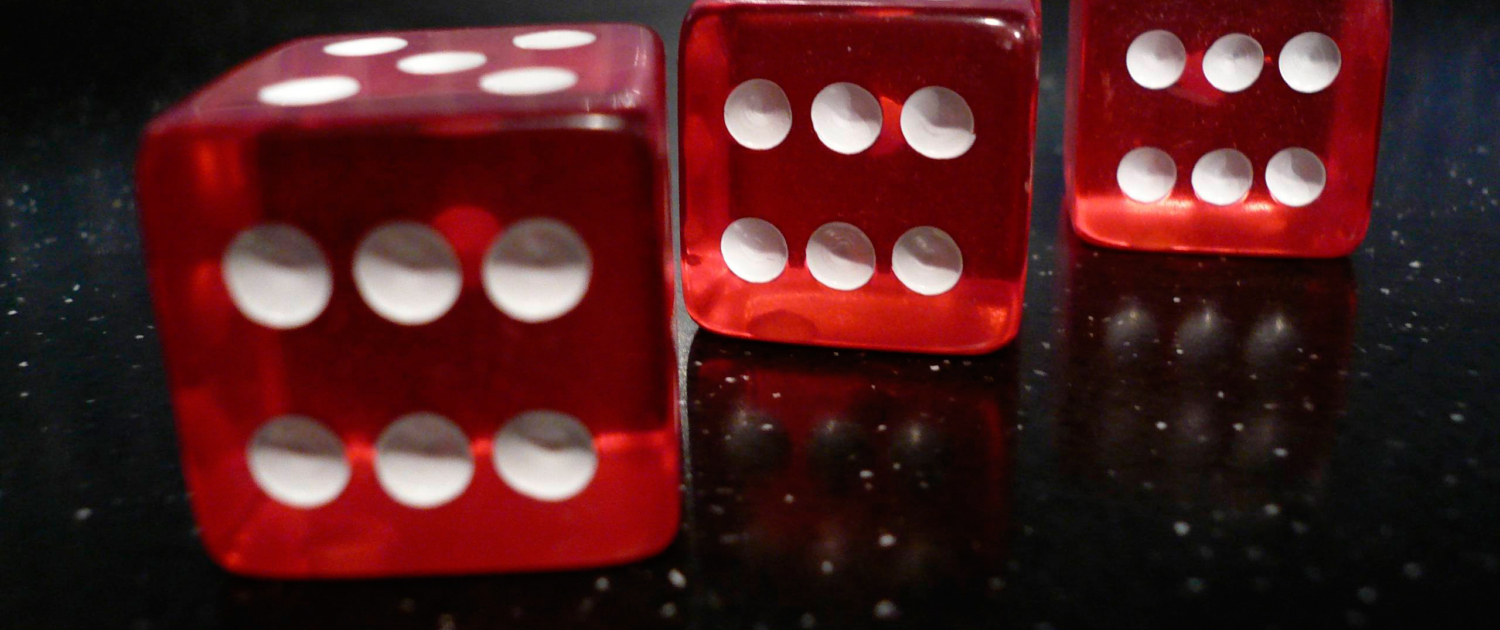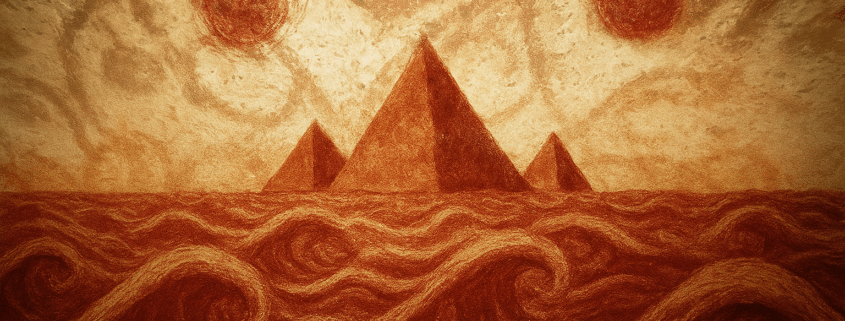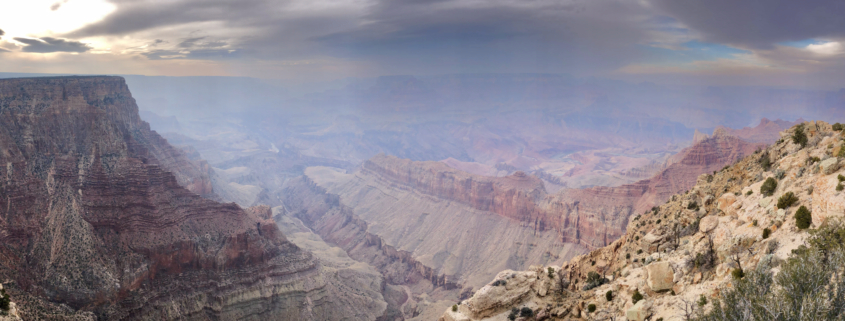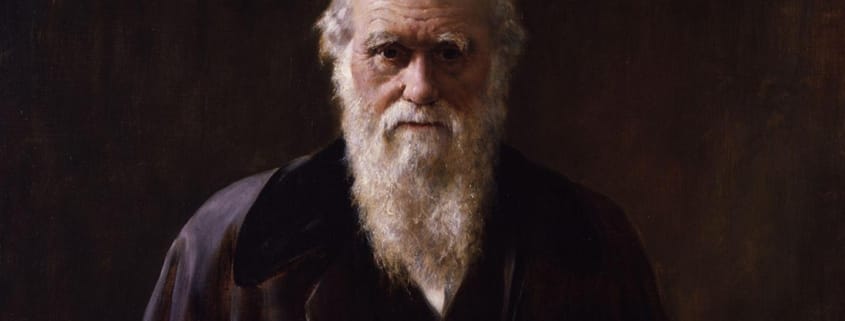666 has been the subject of more comment and speculation than any other cabalistic number, principally on account of the last verse of Revelation 13:
‘Here is wisdom, let him that hath understanding count the number of the beast: for it is the number of a man; and his number is six hundred threescore and six’.
In the Greek text the number is spelt in letters, χξς‘ or 600, 60, 6. The prophetic quality in these words has thrilled the imagination of readers throughout the age. The meaning they bear is remarkable and not easy to understand, for the mystical language of numerology has long been moribund. However, by reference to the ancient canon of the Temple, it is possible to acquire some knowledge of its vocabulary and grammar, which may not unreasonably be applied to the further understanding of prophetic works in which this language was used.
We have already seen the importance of the number 666 in the dimensions of the Temple and in the ratios of metrology, reflecting the dominant position which this number occupies within the hierarchy of powers. 666 is the number of absolute positive energy, emanating from the nucleus to the satellites. Like all symbolic numbers it has no single identity or personification, being of the nature of Plato’s essences, a concept of the mind, invented to express a certain tendency, which is apparent within all classes of phenomena. 6 is the number of the physical creation, the cosmos, and 666, the trinity of sixes, represents the active side of that number, 3 being the first numerical symbol of positive energy. Thus the reference of 666 is to material as opposed to spiritual activity. As an elemental force, 666 represents the sun and the influence of solar radiation, corresponding in society to the emperor, and in the individual to the principle of intellect and will. 666 is the generative power of the male, it is the electric shock that orientates the molecular structure, the leader directing the masses, the word of command instinctively obeyed. There is a tendency in all phenomena towards inertia and relapse into fixed patterns, which is evident both in. physical nature and in the human mind. This tendency, which is characteristic of female and negative influence, is opposed by all that is represented in the number 666. The sun drives the planets and a similar order prevails within the atom; a nation is animated by the strength and justice of its ruler, the individual by his intellect and power of decision. Every situation in life contains an element which corresponds to 666, the supreme solar representative within the hierarchy of numbers. Where the proportions are correct, the influence of the number 666 promotes fertility, gives life and colour, but where it becomes excessively dominant, the consequences are apparent in the tyranny of the self-willed governor, and in the development of a society obsessed with fantasies of violence, material wealth and power. The rays of the sun are filtered through the protective atmosphere, and reach the seed through the medium of the earth. Were it not so they would destroy all. Following this analogy, the number 666, as it appears in the dimensions of temples, must always be combined with numbers of a female, lunar or terrestrial character, and this result may be achieved by the use of the canonical figures of sacred geometry. We have seen in earlier chapters something of the geometrical relationship between such numbers as 666, 1080 and 353 and the importance of 666 in the ratios of the foot to the megalithic yard and other ancient units. Where the proportions of regular geometry are measured by the canonical standards of length, a balanced scheme of numerology will become apparent in the dimensions.
The force of the number 666 is expressed by the Chinese in the symbol of the procreative dragon, relating to the first hexagram of the I Ching oracle. According to Wilhelm’s commentary, ‘the dragon is a symbol of the electrically charged, dynamic arousing force that manifests itself in the thunderstorm. In winter this energy withdraws into the earth; in the early summer it becomes active again, appearing in the sky as thunder and lightning. As a result the creative forces on earth begin to stir again’. Whoever acquires this elemental view of nature is not likely to attribute eternal values to the various theologies and moral codes of human invention, and for this reason the authority of the early Roman Church was in direct opposition to the science of the gnostics, who encouraged their pupils to develop their sensitivity, and to perceive for themselves the interaction of cosmic forces.
The Chinese dragon and the beast in Revelation have the same origin, but the histories of the two creatures have widely diverged since the collapse of the former world order, in which both were represented by the number 666. Wilhelm in his book, Change, writes, ‘In China dragons are not slain; rather their electrical power is kept in the realm, in which it can be made useful’. The Chinese continued to recognise the realities in nature, including the influence of the creative principle, while in the West the ancient philosophy was submerged in the superstition of the dark ages. The Church Fathers were inclined to represent their own prejudices in matters relating to human ethics as the canon of divine law. The dragon as the principle of male sexuality was discredited. The phallic rites of the gnostics and of their rustic successors, the witches, were put down by reverend fanatics in the delusive hope that the devil within might be exorcised through the destruction of his outward symbols. The result, of course, has been the opposite of that intended, for the power of the beast, where it is not recognised and duly placated, grows like a»cancer within the hidden mind until it entirely dominates the motives of its unconscious host. Naive world improvers, who neglect to become acquainted with the material they are dealing with, which is human nature, may believe that by withdrawing recognition from those aspects of psychological reality of which they do not approve, they will cause them to disappear. Thus the well meaning Puritans at the Reformation attacked all symbols and practices relating to the number 666, the ‘steeple houses’, stone crosses, maypoles and the rustic celebrations of seasonal fertility, under the impression that these represented elements hostile to the spirit of Christianity, which they conceived in purely moral terms according to the notions of the time. Reacting against the imperial authority of Rome, which they identified, not unreasonably, with the power of the number 666, the Puritans rejected the solar attributes of Christ and denied the aspects of nature which these reflect. In place of the New Jerusalem, the city in which every element in creation is present in its correct proportion in accordance with its due position in the cosmic scheme, the Puritans attempted to create the utopian state, an affair of purely human contrivance, founded on nothing more lasting than moral ideals, which are nowhere fixed and nowhere identical.
The chief distinction between the New Jerusalem and Utopia is that in the City of Revelation the number 666 is admitted and given its due place in the court of numbers. Utopians, however, being compelled to choose between a great many rival and apparently irreconcilable interests in drawing up the groundplan of their secular temple, must necessarily omit certain numbers and their corresponding principles, those which have no appeal to the contemporary moral sense. The temple of Utopia is not, in consequence, a true model of reality; the appearance of an unknown or unfavoured god throws its priests into confusion and shatters the images of the sacred founders, on whose ideas and opinions the whole structure was erected.
Where the number 666 is not unified with the number 1080 to produce 1746, the mustard seed of fertility, then the two forces, male and female, represented by these numbers, develop symptoms as of sexual frustration. The influence of 666 becomes directed towards violence and destruction, while the female, receptive spirit, 1080, withdraws into the earth, becomes stagnant and takes on the dark, malicious qualities of the elemental. The chief function of the temple was to provide the marriage bed for the union between heaven and earth, in which the two elements were brought together and placed in their correct relationship according to the alchemical formula for the fruitful reconciliation of opposites. 666 is the sun that rules the earth, the emperor set over the people, the intellect governing the senses. This relationship is natural and eternal, productive when there is a proper balance between the elements, a source of friction when there is not. The first step in the development of a true cosmic philosophy must therefore be to recognise the nature of the two contrasting forces and to observe the proportions in which they are most harmoniously unified. If the beast is a native citizen of the New Jerusalem, his place in the scheme must be defined, for the consequences of ignoring his certain presence can only be unfavourable.
The number of the beast
Apocalypse interpreters have flourished during the eighteen centuries since Irenaeus first speculated on the number of the beast. Even among the recent commentators on St John’s Revelation there are few who resist the temptation to put forward the name of their own chosen candidate as the man with the number 666. The literature on the subject is extensive and curious. A great deal of ingenuity has been applied to the discovery or invention of names with gematria of 666. The question has been tried by the most learned as well as the most fanatical, for it concerns an ancient mystery, and its solution is in the extreme blasphemous or liberating according to individual taste. There may appear to be little merit in the subject, but for the benefit of those interested, the various guesses at the identity of the man who bears the number of the beast are summarised below, followed by the solution according to the numerical interpretation of the relevant text.
Irenaeus in his books against heresies makes several suggestions on the interpretation of the number 666, including τειταν, Teitan the name of an archaic solar deity, and λατεινος, Lateinos, a word, of doubtful provenance meaning ‘the Latin’. This second name has been widely accepted, particularly by Protestant theologians, and used in support of the theory that 666 is the number of the Pope. In Revelation 17, the whore of Babylon is seated on a seven headed beast, which is interpreted later in the same chapter as seven mountains. This is naturally seen as a reference to the seven hills of Rome. Phrases such as ἡ λατινη βασιλεια, the Latin kingdom, and εκκλησια ἰταλικα, Italian church, each have the number 666, and so does θεος εἰμι ἐπι γαιης, I am God on earth, an epithet of the Pope. Francis Bacon expressed the matter less tediously when he wrote that, were the description of the Antichrist in Thessalonians to be issued to the police, the Pope would immediately be arrested.
The solar and Apollonian character of the Roman Church is so obviously related to the number 666, that the Pope’s cabalists have had little to say in the matter beyond suggesting in the interests of Christian unity that 666 might apply to the name Μαομετις, Mahomet, which has the appropriate number if spelt in this way. Most English writers appear to have favoured λατεινος, the Pope of Rome, as the name of the man with the number of the beast. The Scottish genius, Lord Napier, who invented logarithms in order to assist his calculations on the measurements of the New Jerusalem, was of this opinion. So was the Rev. Reginald Rabett, the querulous author of a book on 666, published in 1855, in which various interpretations are examined and all shown to be deficient except λατεινος, the Pope. Bishop Wordsworth in his commentary on the Greek New Testament also refers 666 to the Roman Pontiff, and exhibits a Vatican seal, bearing a device with some resemblance to the letters of the beast. However, this sort of thing is no longer the fashion. It is now more tactfully suggested that St John intended the beast to signify the Roman Emperor rather than the Pope, and that his particular reference was to Nero, for in the Hebrew letters Neron Caesar has the value 666, or written in Greek, Νερων Καεσαρ = 1332 (666 × 2). According to Dr Lea, the Rabbis called the Roman language Romiith, the Roman beast, the Hebrew word having the same number as Sorath, 666, the solar force.
It is, of course, gratifying to know that if the English letters are given numbers so that A = 100, B = 101, C = 102 etc., then the number of Hitler is 666; and if Stalin is spelt in Greek letters with the definite article, and, following the precedent of Lateinos, Teitan etc., with a dipthong, ὁ Σταλειν = 666. This name is in fact an anagram of λατεινος.
The Roman emperor, the Pope or Hitler may each in his own way be described by the number 666, for the associations of this number are imperial and authoritarian. It must however be repeated that these numbers have absolutely no application to human moral values. It is not, as the Protestant clergymen believed, sufficient to identify the Pope as the man with the number of the beast in order to discredit the Roman Church, for as the head of an hierarchical organisation, the Pope must combine a strong element of 666 with qualities of a more spiritual nature. No doubt Hitler and his advisers were consciously manipulating the power of 666, for the fascist emblems, the eagle, the swastika, the flash of lightning were all directed towards the release of solar energy among the German people. As the influence that stimulates all activity, this force is not by nature evil, although violent manifestations will occur if it is either repressed or over emphasised. The Nazis invoked the power of 666 for their own immediate use, but failed as it were, to earth it, to bring it into conjunction with its opposite, and allowed it to sweep through the nation unchecked and undirected. The consequence was that the Third Reich, planned in ignorance to endure for an age, burnt out within a few years.
The scriptural phrase that best expresses this violent, elemental aspect of 666 is ὀργη θεου, Wrath of God, which within the permitted latitude of one unit has the value of this number. ἡ φρην, the Greek word for the heart or diaphragm, the seat of the passions, also has the appropriate number 666.
But although 666 is a numerical attribute of any active leader, it is clear that St John intended that the number of the beast should be applied to a particular individual. The words in Revelation 13 are, ‘Let him that hath understanding count the number of the beast: for it is the number of a man’. In the next phrase St John gives the number by which the man is to be identified. This number can be found by the methods which the gnostics themselves would have used in accordance with their known practice. The phrase that gives the number of the beast is translated, ‘and his number is six hundred threescore and six’. In the original Greek it is, και ὁ ἀριθμος αὐτον χξς’. To find the meaning of this phrase, we must add together the values of the individual words of which it is composed. Thus, και = 31, ὁ = 70, ἀριθμος = 430, αὐτον = 1171, χξς‘ = 666. The total value of the phrase, which gives the number of the beast, is therefore 2368, the number of Jesus Christ. Following the cabalistic system of replacing the words and phrases of sacred texts with others of the same numerical value, Revelation 13.18 can be read, ‘Here is wisdom. Let him that hath understanding count the number of the beast: for it is the number of a man; 2368, Jesus Christ’.
There is no question here of a chance coincidence of numbers, for in the same chapter St John emphasises his meaning by use of the phrase, the Image of the Beast, which is repeated three times inverse 15. Now the number of ἡ εἰκων του θηριου, the image of the beast, is 2260 and this number is already familiar as belonging to the Antichrist, whom St Paul describes in II Thessalonians 2.3, using two phrases both of obviously traditional significance.
‘Let no man deceive you by any means: for that day shall not come except there be a falling away first, and that man of sin be revealed, the son of perdition’.
The man of sin is ὁ ἀνθρωπος της ἀνομιας, of which the value is 2260, the same number as the image of the beast. The son of perdition is ὁ νἱος της ἀπωλειας 2385. The number 2260 occurs again in Revelation 14, the chapter following St John’s account of the beast. In verse 14 the Son of Man appears on a white cloud, evidently standing in contrast to the beast from the sea. Yet by number they are made identical, for the Son of Man, ὁ νἱος ἀνθρωπον has the number 2260. Thus
2260
= the image of the beast
= the man of sin
= the son of man
and
2385
= the son of perdition
= δυναμις Χριστου, power of Christ
= το Βαπτισμα Ἰωαννου, the baptism of John (Luke 20.4)
Whatever may now be thought of scriptural interpretation by gematria, there can be no doubt that the early Christian scholars, who practised it, would have recognised St John’s intentions in identifying Jesus Christ and the Son of Man with the image and number of the beast: to draw the attention of his fellow initiates to the state of affairs in which a prophet is idolised by his followers, who raise the image of his body in temples, observing the letter of his law to the neglect of its spirit.
Throughout Revelation, the symbolic figures which appear outwardly to stand most decidedly in opposition to each other are revealed as being essentially one and the same. The duality which, from the human point of view, obtains universally, is an illusion of this world and exists neither in the world of archetypes nor in their corresponding numbers. It has often been remarked that the Greek words, which are applied to the contrasting figures in the apocalyptic vision, are strikingly similar in form. The bride is ἡ νυμφη, the whore is ἡ πορνη. The beast is το θηριον, and the lamb το ἀρνιον, a rare word which scarcely occurs in the New Testament outside Revelation. The scene of the vision continually shifts, so that at one moment the prophet sees the splendour and corruption of Babylon, followed immediately by the holy city, Jerusalem, with its fresh springs and walls of sparkling crystal. The woman clothed with the sun, the beast with seven heads and ten horns, the Lamb on Mount Sion and the whore with the scarlet beast are described in turn. Babylon is destroyed, Jerusalem is revealed. But these are not two different cities. According to their numbers they are identical, for the gematria of Babylon and of the holy city Jerusalem is:
Βαβυλων, 1285
ἡ ἁγια πολις ἡ Ιερουσαλημ, 1285
This use of numbers introduces a new dimension into language. The mystic realises that all he sees and feels is conditioned by his state of mind and by the influences of the time in which he lives. The forms that surround him are no more permanent or real than his perception of them. The city or society to which he belongs is a living organism, at least it behaves like one, following the natural life cycle of growth, decay and renaissance. Excavators of ancient cities almost invariably discover traces of earlier settlements and evidence that the site has been built up and destroyed, abandoned and resettled throughout the rise and fall of civilisation. In one age it is Jerusalem, green and fertile, the home of a vigorous population inspired by the ideals of the prophets. Next the civilised arts are cultivated. The craftsmen become specialists and develop the skills of their particular trade. Temples, markets, public buildings mark the expansion of commerce and the establishment of laws and orthodox beliefs. Finally, the city is no longer self sufficient, but has become the imperial capital, its comfortable population living off the produce of the surrounding countryside, and finding no legitimate outlet for its energy other than in the pursuit of wealth and excitement. Jerusalem has become Babylon, and Babylon perishes through the corruption of its citizens. But these citizens are the same sort of men as were there at the beginning, neither better nor worse, merely placed in a different situation and reacting accordingly.
The prophet, therefore, makes no distinction between Jerusalem and Babylon. In every age there are those like himself, who prefer the study of essences to that of phenomena, who view the situation not exclusively from the point of view of their own time, but with the eyes of humanity as a whole. These men communicate with each other across great stretches of time in the knowledge that their vision has been and will be shared by others. St John writes the language of mysticism in a tradition which in his day was already of incalculable antiquity, and which he knew must appear again at the fulfilment of a cycle. The high mountain from which he saw the New Jerusalem is the prophetic trance. The ages and stages of creation are condensed in one moment. Great trees sprout and fall apart like explosions as Jerusalem becomes Babylon, flares up and resurges from its own ashes. Like a rolling wave in the ocean, the city is not controlled by the individual particles that comprise it, but moves under the influence of greater forces, and these forces are themselves subject to others, following the same patterns of growth and decay, expansion and contraction as are evident in all phenomena throughout the dimensions. The prophet, who is aware of cosmic motion through his own perception, is constantly seeking ways of communicating his experience to others. In former times this was made possible by the use of a metaphysical language of number, constructed by reference to the same canon of proportion as regulated every other facet of human activity. St John was thus able to contrast the delights of Jerusalem with the fate of Babylon while indicating, by giving the two cities names with an identical number, the true relationship between them.
Again, to demonstrate the identical nature of forces, which from the human point of view seem utterly opposed, St John gives the number of the beast in a phrase, και ὁ ἀριθμος αὐτον χξς’, which has the same value, 2368, as Ἰησους Χριστος. This is not unexpected. Napier, Bishop Wordsworth and others have commented on the similarity between χξς’, 666, and Χρς, the cipher of Christ. It has been observed that 666 is related to 2368 in that they are both multiples of 37, and the word θηριον, beast, occurs 37 times in Revelation. This detail is not without significance in canonical literature, for works such as Revelation were planned so that the balance of elements within the various episodes should be repeated in the book as a whole, as well as in the entire body of sacred texts to which it belongs. Thus the first chapter of the first book in the Bible concerns Adam and Eve and the Tree of Knowledge, while the last chapter of the last book, Revelation, ends with the Spirit, the Bride and the Tree of Life.
St John’s purpose in writing the number of the beast in a phrase with the value 2368, the number of Jesus Christ, can only be understood in the context of the bitter disputes throughout the history of the early Church between the bishops of Rome and the prophetic leaders of the eastern communities. The chief source of the gnostics’ heresy in the eyes of the Church lay in the distinction they made between the body of Jesus and the spirit of Christ and their insistence that the spirit alone partook of the divine nature. The further implication was that, while the life of Jesus was mythical, his spirit was eternal, a reality within the possible experience of all, and not only through the offices of the Church. The same idea occurs in all evangelical movements. To the bishops who claimed that the body and spirit of Jesus Christ were alike divine, the gnostics made the logical answer that since divine nature is beyond suffering, and since Jesus is said to have suffered on the cross, therefore his body must have been that of an ordinary man. The same point, whether it should be the image of a man that is worshipped or his spiritual ideal, that is disputed in Russia today, was also the chief issue between the prophets and the priests in the early Church. The gnostics rejected the literal images of the Christian story which the priests emphasised, in particular the representation of the wounded body on the cross. There is a well known gnostic graffito of an ass crucified. Christ was the rising sun of a new age, but the aspect of his nature that dominated the teaching of the Roman Church was related above all to the midday sun, the symbol of imperial splendour. The balance between the Dionysian and the Apollonian Christ was upset in favour of the latter, and this was reflected in the decline of the old prophetic ministry and in the growing power of the bishops, who were originally concerned only with matters of organisation and finance. Particularly in the eastern churches, there were many who deplored this tendency on the part of Rome to glorify the image of the body to the neglect of the spirit. It was due to their influence that Revelation was included in the Scriptural canon, and even this was decided by the narrowest possible majority, for though the significance of the numbers 666 and 2368 would not have been generally understood, St John’s comparison of the idolised body of Jesus Christ with the beast, described in Revelation 13, is not hard to recognise.
The first beast, marked with a deadly wound, rises up out of the sea, which in the language of mysticism signifies the unconscious mind. As the watcher on the eastern shores at dawn feels the first rays of the sun as it clears the ocean horizon, so it is when a new influence, long dormant below the horizon of the mind, begins to affect the dreams and thought patterns of a generation. The beast rises from the sea to begin the period of his reign as the god of a new age. He is followed by another.
‘And I beheld another beast coming up out of the earth; and he had two horns like a lamb, and he spake as a dragon’.
The first beast is of the sea, a spiritual phenomenon, Jesus Christ the fish of the Piscean age; the second is of earthly nature and represents the physical manifestation of the beast, the divine emperor or prince of the Church. He appears as a lamb, but his authority is that of the imperial dragon.
‘And he exerciseth all the power of the first beast before him, and causeth the earth and them which dwell therein to worship the first beast, whose deadly wound was healed . . . saying to them that dwell on the earth, that they should make an image to the beast, which had the wound by a sword, and did live. And he had power to give life unto the image of the beast, that the image of the beast should both speak, and cause that as many as would not worship the image of the beast should be killed’.
For those who had not yet guessed the identity of the beast, whose wounded image was set up as an object of compulsory worship by the second beast, St John then gives the number of his name in a phrase with the value of 2368, Ἰησους Χριστος. The Son of Man, 2260, becomes the image of the beast, also numbered 2260, and in Revelation the great city which spiritually is called Sodom and Egypt (Σοδομα και Αἰγυπτος = 1480) ‘where also our Lord was crucified’ has the number of Christ, Χριστος 1480.
St Paul, whose works were much quoted by the gnostics in their disputes with Rome, made the same point in the first chapter of the Epistle to the Romans, writing of those who ‘changed the glory of the uncorruptible God into an image made like to corruptible man, and to birds, and to fourfooted beasts and creeping things… who changed the truth of God into a lie, and worshipped and served the creature more than the Creator’.










